A camping trip to Alaska has always been my idea of the ultimate adventure. I had been considering this trip for several years but not many of my friends were willing to commit to the cost, risk, or time. Eventually my brother, Mark, and my oldest son, Chris, became interested so we scheduled it for June, 1988.
On trips to the Boundary Waters or Quetico, getting lost means that you may spend a few extra days in the wilderness, but chances are that eventually you would find your way out or someone will rescue you. If you get lost in Alaska the archeologists will probably find your bones centuries later. Also the grizzly bears up there have a different agenda than the black bears we dealt with in the BW. The other factor to consider is the tides. If you do any kayaking and don’t know how to read tide tables your body could wind up in Tokyo bay or some other far-away place. Because of these factors we thought it prudent to hire a guide.
We searched the ads and found an outfitter called “Camp Alaska Tours”. This company furnished a guide with a van and would take a group of up to 8 persons. They would sub-contract other outfitters and tailor-make a trip with activities that interest the group. Among the things that interested us were sea kayaking and rafting. We also wanted to do some salmon and halibut fishing along with exploring some glaciers and towns. We hired Camp Alaska as our main outfitter. They in turn hired other outfitters and guides for the sea kayaking and rafting.
We decided to fly to Seattle and take the Alaska Ferry to Juneau through the inside passage. We would spend a day in Juneau, then fly to Anchorage and be picked up by Camp Alaska Tours to continue our adventure.
On arriving in Seattle we were met by our cousin John Paulus who offered to keep us at his home and show us around the area. John lives in the suburbs with his wife, Gay. He is a retired engineer from Boeing, skier, kayaker, and amateur herpetologist. He spends his retirement visiting schools in the area lecturing and showing live snakes to the kids.
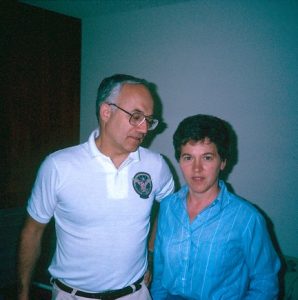
John and Gay Paulus – June 1988
John gave us a tour of the area showing us the salmon fish ladders and other points of interest.
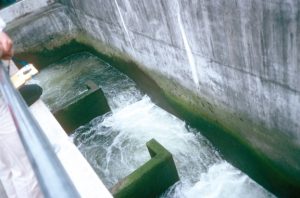
Fish Ladder on the Columbia River, Seattle
After spending two days with John and Gay we headed to the ferry port for our ride through the inside passage.


Alaska Ferry
The Alaska ferry takes passengers, vehicles, and supplies from the lower 48 up to Alaska and the Aleutians. Passengers can book cabins or sleep wherever they can find room – a stairwell, deck, or hallway. We booked a cabin with 3 bunks to use during the 3 day trip from Seattle to Juneau.
There were many loaded semi-trailers on board to be hooked onto tractors when they arrived at their destination. Also aboard were many interesting people – adventurers, tourists, college students, business men. Many of the college kids had summer jobs in fish canneries or on fishing trawlers. They had put up tents on the rear deck forming a kind of “tent city”.
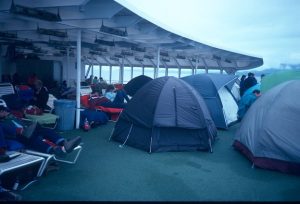
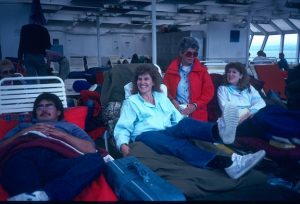
“Tent City”
We even met a condom designer from Cincinnati. Mark tried to pick his brain for “engineering advice”.
The scenery in the passage is wild and fascinating. Along with barges carrying grain, bales of hay, cement blocks, coal, and other supplies, are glaciers, bald eagles, orca whales, and other wildlife rarely seen in the lower 48.

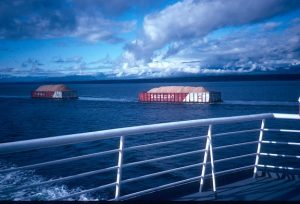
Barges on the Inside Passage
The ferry stops at some of the small villages along the inside passage. The climate here is oceanic so it rains almost constantly. The rain forests have trees that look as if they have hair growing on their trunks. Many of the school playgrounds have a roof to keep the rain away.
We disembarked at Ketchikan and were able to tour the town on foot since it is small and doesn’t go far inland. It is interesting for its totem poles.
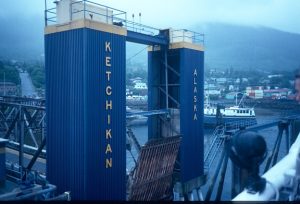
Ketchikan Ferry Dock
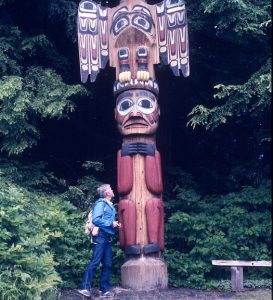
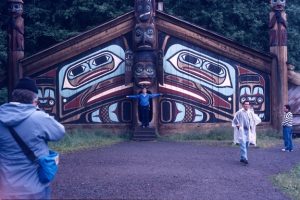
Totem Poles in Ketchikan
There were some buildings built out over the water on stilts that were said to be houses of prostitution during the Alaska gold rush. One wag pointed out that this is where both fish and fishermen spawned in the same place!
We stopped at Wrangell for an hour to unload passengers and supplies, also at Petersburg where a large number of college students disembarked to work in salmon canneries. These villages along the shore were very picturesque although somewhat primitive by lower 48 standards.
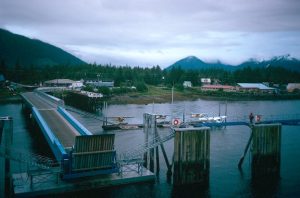
Ferry Dock at Petersburg
After 3 days in the passage we arrived in Juneau and disembarked.
Juneau is cradled between the Pacific shore, a large mountain, and the Mendenhall Glacier. Along with being the state capital it is a fishing village with docks for a large fleet of boats and fishing trawlers. To serve the many cruise ships that stop are tourist shops, restaurants, bars, and nightlife. Everything appears to go uphill from the ocean. It reminded me of an “old west” version of San Francisco.
We rented a car, toured the town and visited the Mendenhall Glacier. We could drive 15 miles or so – blocked in by the sea and the mountains.
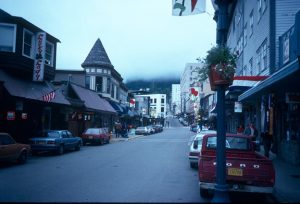
Juneau Alaska
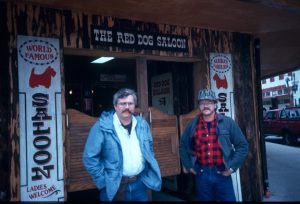
Two Gunslingers In Front of the Red Dog
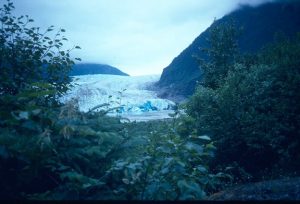
Mendenhall Glacier – Juneau, Alaska
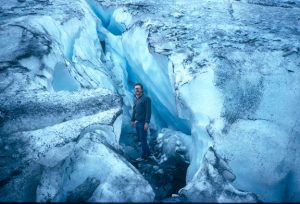
Don’t try this at home!
We happened to be in Juneau on July 4, 1988, so we were privileged to see their independence day parade. It consisted of the usual trappings – fire trucks, boy scouts, small floats, kids on bicycles, dogs, etc. I was struck by the fact that we were in the capital of the largest state in the union and its 4th of July parade was smaller than the one in Randolph, the small Ohio town where I was raised.
After spending the day in Juneau we boarded our flight to Anchorage.
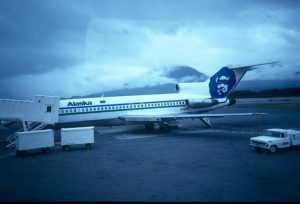
That’s an image of a native Inuit on the tail (I thought it was Johnny Cash!)
Arriving at the Inlet Inn hotel we met Mike, our guide from Camp Alaska. Mark and Chris had both brought 44 Magnum revolvers along as grizzly bear protection but Mike talked them into leaving these in the hotel safe to be picked up at the end of our trip, pointing out that the guns were not needed since each guide would carry one.
The next morning we met the 3 other members of our tour, Bob, Nancy, and Glen. We packed our gear into Mike’s van and headed for Portage, about an hour drive. After visiting Portage Glacier, we boarded the train for Whittier where we were to start our kayaking trip into Prince William Sound.
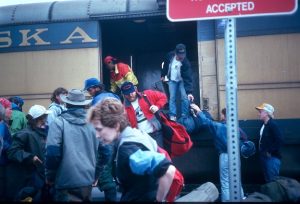
Kayakers, fishermen, and other adventurers boarding the train to Whittier
Whittier is a very small town on Prince William Sound, It consisted of a few houses, trailers, old buildings, restaurant in an old house trailer, an abandoned Army barracks, and a marina to service the fishing fleet. The town taxi service was a kid driving an old Pontiac convertible. The only way into Whittier was by sea or train. Except for the marina, this place looked like the back doors of hell!
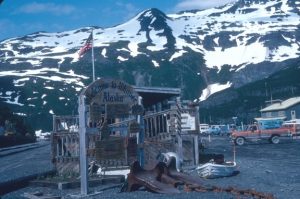
Whittier, Alaska
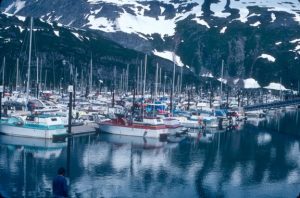
Whittier Marina
We entered the restaurant trailer for lunch. At the same time one of the fisherman brought in a bushel basket full of fresh large shrimp straight from one of the trawlers. They looked so good that we all ordered shrimp, and they were every bit as good as they looked. Remember, this was 1988, a year before the Exxon Valdez accident that dumped a tanker-load of oil into the sound.
We now had with us Bob Hakenen from the Hugh Glass Backpacking Company who was to be our kayaking guide. Bob furnished us with Klepper kayaks which come in canvas bags as a bundle of sticks and rubberized cover. For safety reasons it is unlawful in Alaska to carry kayaks or canoes lashed to the pontoons of a plane as we did in Canada or lower US. Chances are if these broke loose the plane would probably go down somewhere unreachable, so the only kayaks available were those that could be dis-assembled and carried inside a bush plane.
We loaded a large dory and smaller motor boat with the kayaks in canvas bags along with our gear, then headed out into Prince William Sound. After about two hours we were dropped off on a beach of glacial outwash close to the mouth of a fjord with a large glacier at the far end. We unloaded our stuff and the boats departed, leaving us alone in the fjord, telling us they would be back in 4 days to pick us up.
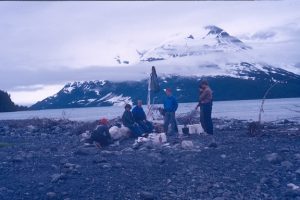
Abandoned!
After erecting our tents and assembling the Kleppers, we gathered firewood, and “Bob the guide” cooked a meal. For bear protection the cooking area was placed 50 yards from the tents. There were no trees on which to hoist the food to protect it from bears. Bob buried it in a shallow hole and kept the site clean and smell-free, hoping the bears wouldn’t find it.
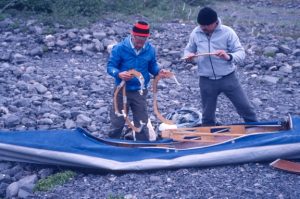
Put stick X into hole Y
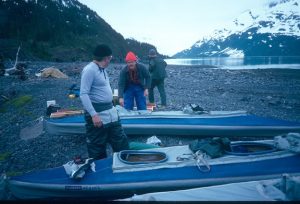
Our campsite in Harriman Fjord
After being on the camp site for only a small time we discovered something that would nag us for the next 4 days. We had been dropped off right in the middle of a tern rookery. The baby tern chicks were scampering around on the ground while their parents were giving us grief by diving at us from above. We could barely move without being attacked. These guys would dive at our heads and let out a loud squawk. We learned to hang a pan or other object on a branch and hold it over our heads as we walked to keep the little buggers from parting our hair.
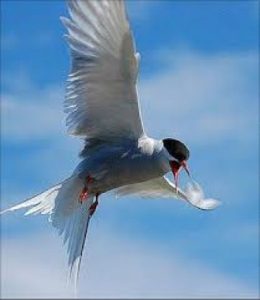
Arctic Tern
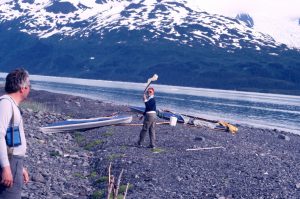
Gene fights off terns with a roll of toilet paper
Another strange thing – it always seemed to be thundering – but it never rained. On further observation we noticed that we could see 10 glaciers from our campsite. The thunder was caused by the glaciers calving and the sound was echoing off of the surrounding cliffs. The glaciers were so far away that the noise from the calving arrived later than the visible event, so we could never see it by tracing the noise.
At 11PM we turned in. It was still broad daylight!
When kayaking, each person took along his/her sleeping bag and used it as a back cushion. In case a person falls into the water, putting him in the bag would keep him from getting hypothermia on the way back to camp.
Paddling in the fjord was a unique experience. Our kayaks were often surrounded by small icebergs that were slowly melting. Because they had been formed under pressure small air bubbles were trapped inside, and they popped and sizzled as they melted giving the impression that we were paddling around in a very large pool of gin and tonic! Our guide told us that people from Japan were buying this ice to put in drinks because they liked the popping noise it made as it melted.
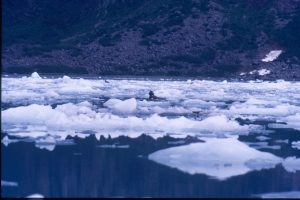
Otters playing among small icebergs in the fjord
Harriman Fjord was surrounded by mountains which had many hanging glaciers. With the thunder, unbelievable scenery, glaciers and the fizz from the icebergs, paddling around in there was an experience difficult to describe.
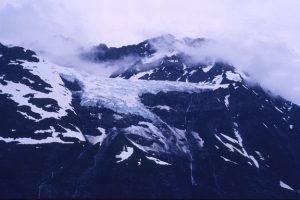
Hanging Glacier in Harriman Fjord
At the far end of the fjord was Harriman Glacier, the “big daddy” that had formed the fjord. We decided to paddle up to this glacier to give it a closer look – a trip that appeared to be about a half-hour paddle. After paddling two hours, it seemed that we were not getting any closer. The distances are so vast that it fools the mind. After more paddling we came within one quarter mile of the glacier. Our guide warned us not to go closer, because if it calved, the wave from the chunk falling into the fjord would swamp the kayaks.
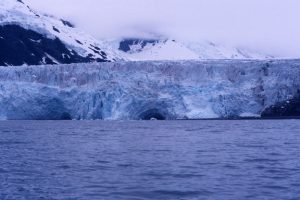
Harriman Glacier
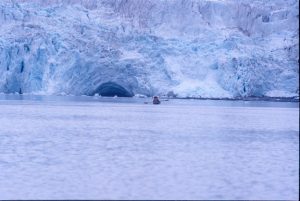
Getting closer!
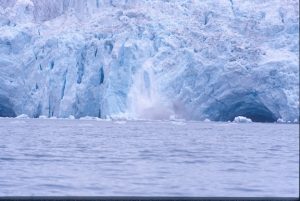
Calving
One time when exiting our kayak I forgot to button the pocket that contained my camera, and it fell into the water. The water in the fjord is a mixture of salt water from the ocean and fresh water from the glaciers, so is not healthy for the interior of an electronic device. On getting back to camp I set the camera on top of my duffel bag to dry and it started taking pictures by itself non-stop. After about one half hour it stopped – never to work again.
So here I was on the trip of a lifetime surrounded by unbelievable scenery without a camera. Mark had an extra camera with him, so he took pity on me and loaned me his.
On several occasions a large catamaran called the “Klondike” would visit the fjord. The tourists on board were leaning over the rail taking OUR pictures! We wanted to “moon” them but Nancy vetoed the idea.
After 4 days of paddling in this breath-taking environment, we disassembled the kayaks, said goodbye to Harriman Fjord, boarded the motor boats, and headed back to Whittier to move on to our next adventure.
To be continued.
More pictures HERE